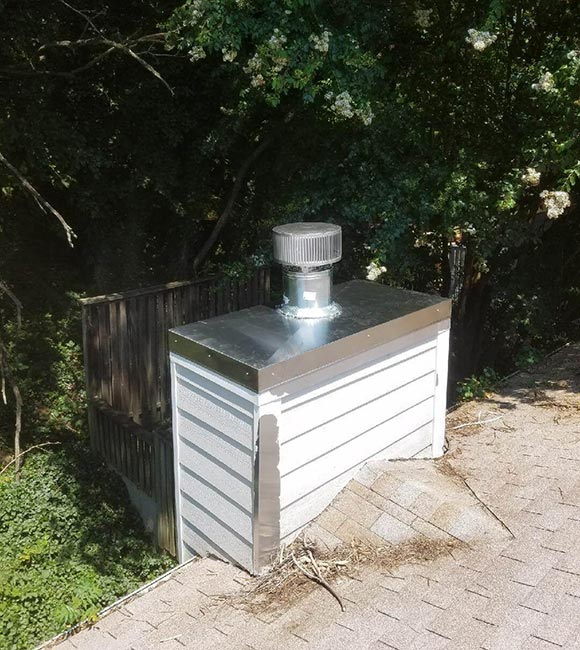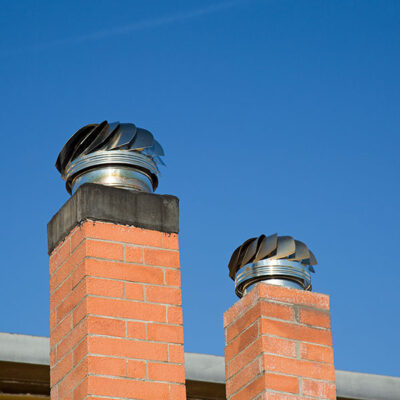Chase Covers
Quality Chimney Chase Covers from ChimneyTek
We Sell and Install Protective and Attractive Chimney Chase Covers
Today, prefabricated or factory-built chimney systems are more popular than ever. They are affordable, lightweight, and designed to be installed quickly, which makes them a popular choice for homeowners on a budget or those lacking an area strong enough to support a masonry chimney system. But just like their masonry counterparts, factory-built chimney systems rely on key components for protection against animals, debris, and moisture. In the masonry world, the chimney crown is what seals off the chimney top. But in the prefab world, this piece is referred to as the chase cover.

Why It’s Important to Have a Quality Chase Cover
Without a chase cover, your prefabricated chimney will be under constant attack from rain, snow, and sleet (depending on the season), and will be vulnerable to animal, bird, and debris entry. Not only can all of these things cause damage like rust and corrosion, but they can also easily lead to a house fire when they come into contact with the high heat produced by your fireplace, insert, or stove. All of these things can be dangerous and expensive to fix, which is why prevention is key.
Problems Caused by Deteriorating External Chimney Covering
Chase covers deteriorate over time, and usually need to be replaced every seven to 10 years. Many are constructed with galvanized sheet metal, and over time the coating will erode due to temperature changes and environmental exposure. If you notice rust forming on your chimney cover, it is time to replace it.
If your chase cover is damaged or deteriorated, it can cause expensive water damage. Water seeping into your chimney’s structure can degrade the chimney pipe, as well as causing the walls around the chimney to begin to rot. In addition, a deteriorated chimney cover can fail to prevent debris from getting inside your chimney, leading to blockages and fire hazards.
Types of Chimney Chase Covers
Chase covers are made of metal and sit right on top of the chase itself, which is the metal enclosure surrounding the chimney flue where it extends past the roof. The most common materials used are galvanized steel, stainless steel, copper, and aluminum.
- Galvanized steel is the most inexpensive option, but needs to be replaced every few years as it can rust quickly in rainy climates like Baltimore.
- Copper is usually the most expensive option because it is of the highest quality. Not only is it durable and rust-resistant, it has a unique aesthetic appeal.
- Stainless steel is one of the most durable and longest-lasting options. It does not rust, which means less maintenance and replacement is required.
- Aluminum is a softer metal, which means it is more easily damaged in places with high winds. However, aluminum chimney chase covers are a great inexpensive option in Baltimore, due to their resistance to rust and corrosion.

Turn to ChimneyTek for Your Decorative Chimney Hole Covers
Keeping your prefabricated chimney system protected doesn’t have to be hard. In fact, with ChimneyTek, it’s easy. We’ll measure your chimney chase and find a chase cover that perfectly fits with your chase. We have a number of decorative designs to match the style of any home.
Our Baltimore technicians are certified by the Chimney Safety Institute of America (CSIA) and have over 20 years of experience fitting and installing chase covers of all types and sizes. We’ll make sure your new chase cover is installed properly and ready to protect your prefabricated chimney, season after season.
If you’re in need of a new chase cover or would like to have yours inspected for proper fit and condition, call ChimneyTek today or book online. We’re here to make prefabricated chimney care and maintenance easy, stress-free, and affordable.
Turn to ChimneyTek for Your Decorative Chimney Hole Covers
Keeping your prefabricated chimney system protected doesn’t have to be hard. In fact, with ChimneyTek, it’s easy. We’ll measure your chimney chase and find a chase cover that perfectly fits with your chase. We have a number of decorative designs to match the style of any home.
Our Baltimore technicians are certified by the Chimney Safety Institute of America (CSIA) and have over 20 years of experience fitting and installing chase covers of all types and sizes. We’ll make sure your new chase cover is installed properly and ready to protect your prefabricated chimney, season after season.
If you’re in need of a new chase cover or would like to have yours inspected for proper fit and condition, call ChimneyTek today or book online. We’re here to make prefabricated chimney care and maintenance easy, stress-free, and affordable.
